I feel like Diogenes, the Greek philosopher who walked around with a lantern searching for an honest man. As a physicist, I forever search for the truth, but I’m often disappointed.
Many people would have you believe that the truth is variable depending on your point of view, but that just isn’t the case. Science will eventually point out the truth if experiments are properly conducted, but we must be careful what we read, because journalists aren’t technically trained, and R&D is sometimes financed by those protecting their business interests.
For example, I keep reading that corn-based ethanol reduces CO2 emissions and can enable better fuel economy. Corn-based ethanol was initially a stop-gap energy independence measure until cellulosic ethanol could be commercialized. The science simply doesn’t support what “Big Agriculture” and farmers would have you believe.
I have considerable experience with fuel economy, so I feel qualified to speak on the subject. Fuel economy is very vehicle/operating condition specific, so let’s separate highway and urban operation for purposes of this discussion. It will simplify matters somewhat.
Want more insight from John Martin? Click here to see all of his columns.
Only 35% to 40% of the energy engines produce actually produces usable work. Significant fuel economy gains can be realized by improving engine efficiency. Since the fleet operator can’t legally alter the performance of an existing engine design, improvements are left to the engineers. However, run your engines as slowly as possible to reduce pumping losses.
Pure science sometimes gets bastardized because of government regulations. An excellent measure of engine efficiency is NOx levels, but California and other areas such as the Northeast have found a relationship between NOx and smog formation. Their constant pressure to reduce NOx levels has an adverse effect on vehicular fuel economy that all Americans must pay for.
Our federal government should devote billions of R&D dollars to the development of NOx absorbers. NOx absorbers would lower the amount of NOx in the exhaust stream thus enabling engines to operate more efficiently. Hopefully, development will happen if an NOx absorber champion starts the R&D ball rolling.
Over-the-road fuel economy, according to the U.S. Department of Energy, places almost four times as much emphasis on aerodynamics and almost two times as much emphasis on rolling resistance as does urban operation. You can debate the numbers, but you can’t debate the directional correlations.
We’ve done a lot of work with bearings, drivelines and tires to reduce rolling resistance, but we’ve barely scratched the aerodynamics surface. Let’s see a lot more truck and trailer manufacturer cooperation to develop some really slick vehicles. I know we can do it. Truck builders may have to sacrifice a little weight, and fleet operators may have to take a little more time changing tires.
Urban operation requires a different tack. Weight is the primary factor influencing fuel economy in these operations, or, as Isaac Newton would say, “F=ma.” (Force acting on an object is equal to the mass (m) of an object times its acceleration (a).)
I like to use UPS as the example. UPS uses only a large enough vehicle to handle the number of packages on a given route to maximize fuel economy. They also use four-wheel disc brakes on most of their package cars to both speed up/simplify maintenance and improve fuel economy.
A fleet operator can learn a lot by simply observing UPS. Don’t carry unnecessary weight!














